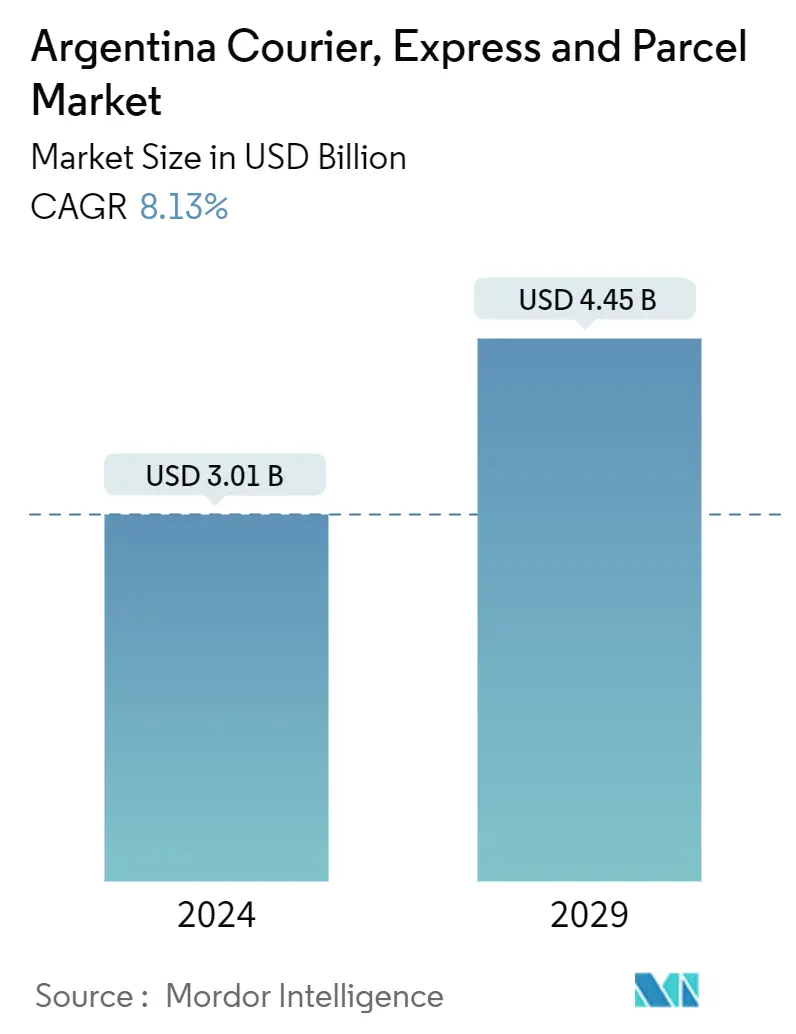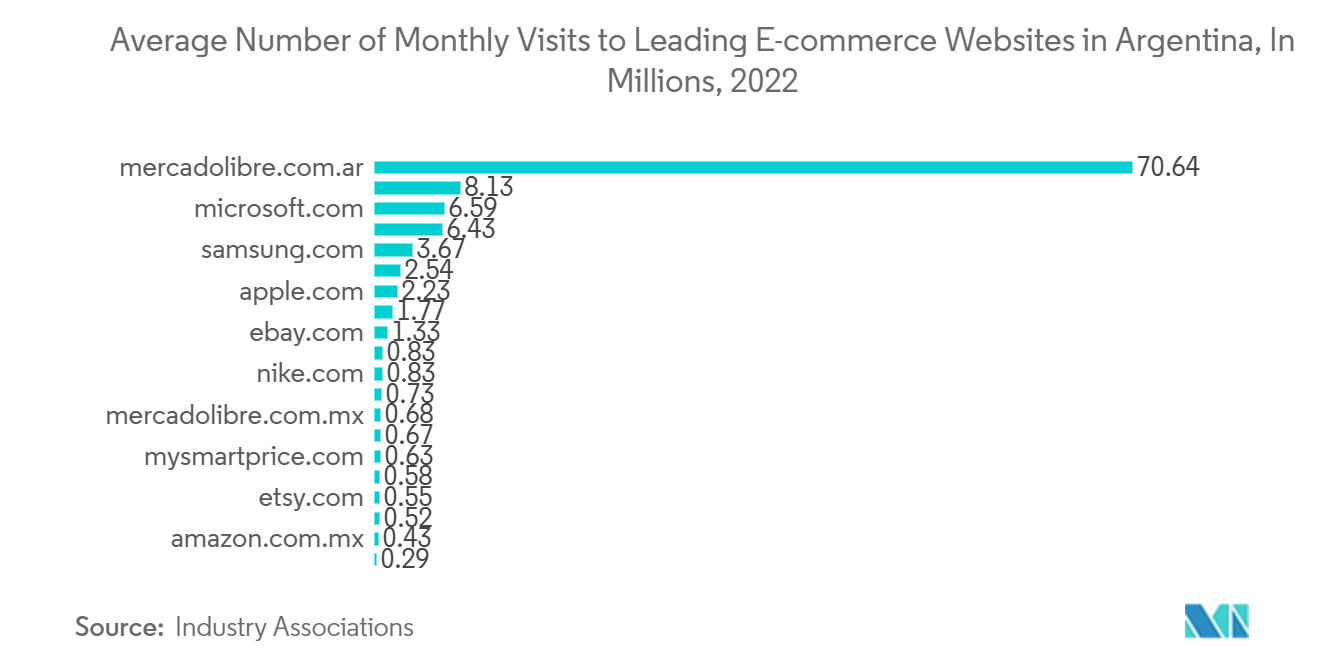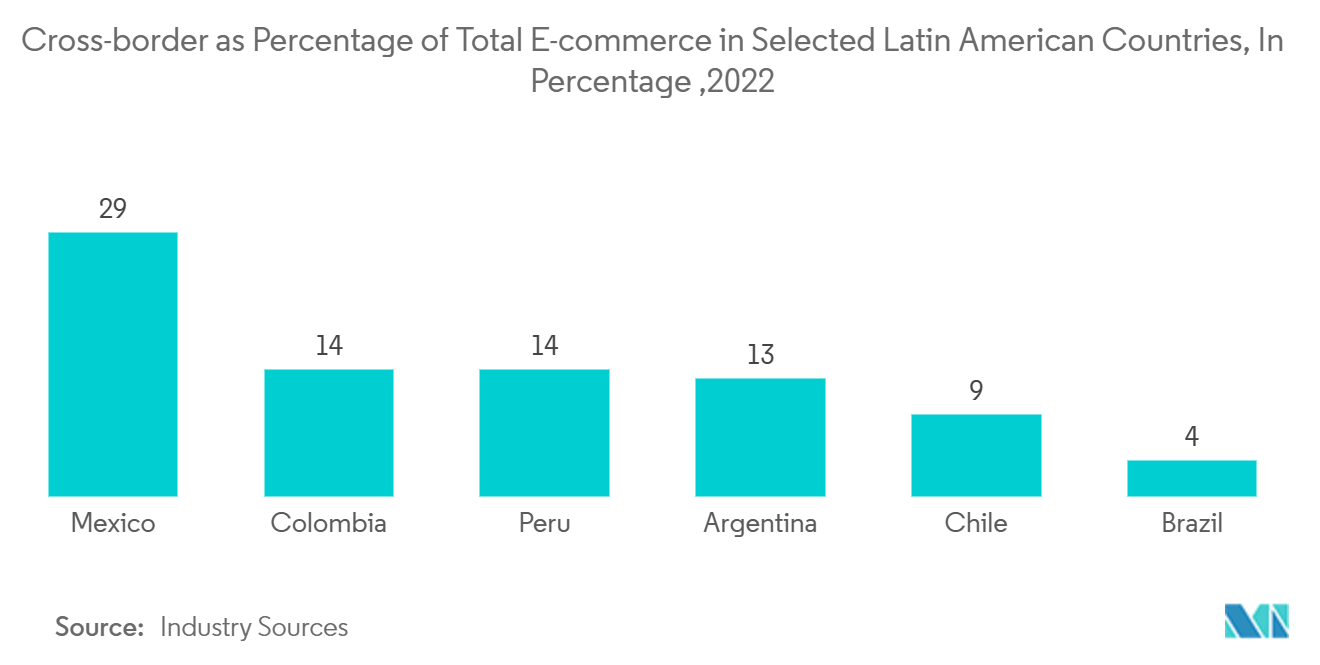Argentina Courier, Express And Parcel Market Size

| Study Period | 2019-2029 |
| Base Year For Estimation | 2023 |
| Market Size (2024) | USD 3.01 Billion |
| Market Size (2029) | USD 4.45 Billion |
| CAGR (2024 - 2029) | 8.13 % |
| Market Concentration | Medium |
Major Players_-_Copy.webp)
*Disclaimer: Major Players sorted in no particular order |
Argentina Courier, Express And Parcel Market Analysis
The Argentina Courier, Express And Parcel Market size is estimated at USD 3.01 billion in 2024, and is expected to reach USD 4.45 billion by 2029, growing at a CAGR of 8.13% during the forecast period (2024-2029).
Investment in e-commerce has become increasingly popular in Latin America. The number of mobile users is soaring, internet penetration rates are increasing, and more and more Latin Americans are having access to financial services.
- As a result, online retailers are considering Latin America as a logical next step in their global expansion. Argentina also has the fastest-growing e-commerce market in all of Latin America.
- When compared to the economic giants of Mexico and Brazil in Latin America, Argentina might appear to be a minor player. However, Argentina more than competes on the internet.
- The greater Buenos Aires region is home to a significant portion of Argentina's population and economic activity. The majority of the population is of European heritage, and it still maintains close relations with Europe on an ethnic, cultural, and commercial level. Compared to other Latin American nations, Argentina's consumer preferences are more similar to those of Europeans in several ways.
- One of Argentina's main trading partners is still the United States. The market has seen great success for many American businesses, and American goods are well-known for their high quality and cutting-edge technology. American consumption and lifestyle patterns influence Argentina.
Argentina Courier, Express And Parcel Market Trends
E-Commerce And Omnichannel Retail Driving the Market
Since 2000, the size of the e-commerce market in Argentina has increased ten times and constituted just over 6% of the market. Experts predicted a substantial increase in Argentine e-commerce before the pandemic, and this prediction unquestionably came true. Argentina was second in Latin America to Brazil in 2022 and ranked sixth among the top 10 nations for retail online sales growth.
Between 2020 and 2022, the amount of food and beverage sold online will quadruple. For the first time this year, the category will outperform furniture and home furnishings in e-commerce sales. By e-commerce sales volume, food and beverages will likely surpass clothes and accessories in 2024 to become the second-largest category in the nation.
Argentina's retail e-commerce penetration is comparable to that of nations with more developed economies. E-commerce sales will represent 12.0% of all retail sales in the nation this year. With that, Argentina will edge over France (11.9%), Germany (11.1%), and Australia (11.1%).
In 2022, almost a million adults aged 14 and older will purchase anything online for the first time. Argentina has 21.5 million digital consumers, or nearly 60% of the population in that age group, who will make at least one online purchase this year.

E-commerce Across Borders Promoting International CEP Market Growth
The United States is Argentina's main commercial partner, which has allowed many American web enterprises to enter the market. However, there are some rules. Argentina has two regulated consumer import frameworks that must be followed by consumers who want to purchase goods from other nations: "door-to-door" and "small package."
Despite economic setbacks and a disruption in global logistics, cross-border e-commerce purchase volumes have grown steadily in both Argentina and Chile since the pandemic. Although Chile's market is still more developed than that of its neighbor, both are expected to expand at a healthy rate.
One of the main drivers of the CEP market's growth is the expanding e-commerce industry, which also contributes to the expansion of cross-border trade. The growth of cross-border trade routes, particularly in developing countries, has accelerated the uptake of global commerce and B2C deliveries. Additionally, the preference of consumers to shop online through various e-commerce portals is boosting market expansion. To ship their goods to domestic and foreign regions, e-commerce stores collaborate with courier service providers.
Another shipping choice that Argentines may start using is the package manager model, in which local businesses handle the logistics and cross-border e-commerce purchasing processes. A U.S.-based warehouse is used in the procedure, which enables clients to make purchases from any location in the world and have them delivered to the warehouse. As soon as the packages are received, they are combined into one huge package and sent to Argentina. The small-package approach then applies in terms of fees and taxes.

Argentina Courier, Express And Parcel Industry Overview
Argentina's courier, express, and parcel (CEP) market is highly competitive and fragmented. To extend their businesses globally and occupy new markets, DHL, FedEx, and UPS keep doing so. E-commerce is still a major force in the development of the international express and small packages sector. To expand their geographic reach, service offerings, and product portfolios, businesses strive to grow both organically and inorganically. To build a regional logistics network, the multinational players are strategically investing in new distribution centers, smart warehouses, etc. Local businesses compete fiercely with global corporations that have fairly well-developed infrastructure. The advantage still belongs to indigenous enterprises in the regional setting.
Argentina Courier, Express And Parcel Market Leaders
-
DHL
-
FedEx
-
United Parcel Services
-
Bollore Logistics
-
Moova
*Disclaimer: Major Players sorted in no particular order
.webp)
Argentina Courier, Express And Parcel Market News
- September 2023: The flights were to be conducted on DHL Boeings 767-300; Argentina was the first country in the DHL network to have its aircraft. The aircraft is expected to have a payload capacity of 52 tons. The flights will likely take place six times a week and will connect the United States with Ezeiza Airport as well as the most important hubs of the region. This means that packages and documents can be delivered to various countries in the region within 24 hours, significantly reducing transit times. DHL offers companies high-quality transportation between the USA, Argentina, and the major DHL hubs of the region all year round, without relying on commercial air traffic during peak times.
- May 2023: EnviAR, Argentina’s new parcel delivery tracking and traceability system, was launched by the Minister of Public Innovation. EnviAR will allow parcel delivery to be tracked and monitored by postal and courier companies, including those that don’t currently have traceability systems in place.
Argentina Courier, Express And Parcel Market Report - Table of Contents
1. INTRODUCTION
- 1.1 Study Assumptions
- 1.2 Scope of the Study
2. RESEARCH METHODOLOGY
3. EXECUTIVE SUMMARY
4. MARKET INSIGHTS
- 4.1 Current Market Scenario
- 4.2 Value Chain/Supply Chain Analysis
- 4.3 Government Regulations and Initiatives
- 4.4 Technological Trends and Automation in the CEP Industry
- 4.5 Insights on the E-commerce Industry (Domestic and Cross-border E-commerce)
- 4.6 Insights on Startups, Venture Capital Funding in the CEP Industry
- 4.7 Brief on Courier Rates
- 4.8 Elaboration on Storage Functions and Value-added Services in CEP Business
- 4.9 Insights on the Reverse Logistics and Same-day Delivery Market
- 4.10 Impact of COVID-19 on the Market
5. MARKET DYNAMICS
-
5.1 Market Drivers
- 5.1.1 E-Commerce And Omnichannel Retail Driving the Market
- 5.1.2 E-commerce Across Borders Promoting International CEP Market Growth
-
5.2 Market Restraints
- 5.2.1 Limited Visible of Shipments
- 5.2.2 Increasing Transportation Cost
-
5.3 Market Opportunities
- 5.3.1 Digitization in the Logistics Industry
-
5.4 Porter's Five Forces Analysis
- 5.4.1 Bargaining Power of Suppliers
- 5.4.2 Bargaining Power of Consumers/Buyers
- 5.4.3 Threat of New Entrants
- 5.4.4 Threat of Substitute Products
- 5.4.5 Intensity of Competitive Rivalry
6. MARKET SEGMENTATION
-
6.1 By Business
- 6.1.1 B2B (Business-to-Business)
- 6.1.2 B2C (Business-to-Consumer)
- 6.1.3 C2C (Consumer-to-Consumer)
-
6.2 By Destination
- 6.2.1 Domestic
- 6.2.2 International
-
6.3 By End User
- 6.3.1 Services (BFSI (Banking, Financial Services and Insurance))
- 6.3.2 Wholesale and Retail Trade (E-commerce)
- 6.3.3 Manufacturing, Construction, and Utilities
- 6.3.4 Primary Industries (Agriculture, and Other Natural Resources)
7. COMPETITIVE LANDSCAPE
8. Overview (Market Concentration and Major Players)
9. Company Profiles
- 9.1 DHL
- 9.2 FedEx
- 9.3 United Parcel Services
- 9.4 Bollore Logistics
- 9.5 Moova
- 9.6 TASA Logística
- 9.7 Treggo
- 9.8 Avancargo
- 9.9 Agunsa Logistics
- 9.10 Dibiagi Transport
- 9.11 NNR Global Logistics*
10. FUTURE OUTLOOK OF THE MARKET
11. APPENDIX
** Subject To AvailablityArgentina Courier, Express And Parcel Industry Segmentation
CEP is an acronym for courier express parcel services, which provides logistical services locally. The speed, weight, and volume of the packages, as well as how the goods are shipped, vary depending on the service providers' offers. Particularly the weight and volume limitations enable significant standardization and offer great potential for automating the operation.
The report provides a comprehensive background analysis of Argentina's CEP market, covering the current market trends, restraints, technological updates, and detailed information on various segments and the competitive landscape of the industry. Additionally, the COVID-19 impact has been incorporated and considered during the study. Argentina's courier express parcel market is segmented by business (B2B, B2C, and C2C), Destination (domestic and international), By end user (services, wholesale and retail trade, manufacturing, construction, utilities, and primary industries).
The report offers the market size and forecasts in value (USD) for all the above segments.
| By Business | B2B (Business-to-Business) |
| B2C (Business-to-Consumer) | |
| C2C (Consumer-to-Consumer) | |
| By Destination | Domestic |
| International | |
| By End User | Services (BFSI (Banking, Financial Services and Insurance)) |
| Wholesale and Retail Trade (E-commerce) | |
| Manufacturing, Construction, and Utilities | |
| Primary Industries (Agriculture, and Other Natural Resources) |
Argentina Courier, Express And Parcel Market Research FAQs
How big is the Argentina Courier, Express And Parcel Market?
The Argentina Courier, Express And Parcel Market size is expected to reach USD 3.01 billion in 2024 and grow at a CAGR of 8.13% to reach USD 4.45 billion by 2029.
What is the current Argentina Courier, Express And Parcel Market size?
In 2024, the Argentina Courier, Express And Parcel Market size is expected to reach USD 3.01 billion.
Who are the key players in Argentina Courier, Express And Parcel Market?
DHL, FedEx, United Parcel Services, Bollore Logistics and Moova are the major companies operating in the Argentina Courier, Express And Parcel Market.
What years does this Argentina Courier, Express And Parcel Market cover, and what was the market size in 2023?
In 2023, the Argentina Courier, Express And Parcel Market size was estimated at USD 2.77 billion. The report covers the Argentina Courier, Express And Parcel Market historical market size for years: 2019, 2020, 2021, 2022 and 2023. The report also forecasts the Argentina Courier, Express And Parcel Market size for years: 2024, 2025, 2026, 2027, 2028 and 2029.
Argentina Courier, Express And Parcel Industry Report
Statistics for the 2024 Argentina Courier, Express And Parcel market share, size and revenue growth rate, created by Mordor Intelligence™ Industry Reports. Argentina Courier, Express And Parcel analysis includes a market forecast outlook to for 2024 to 2029 and historical overview. Get a sample of this industry analysis as a free report PDF download.



